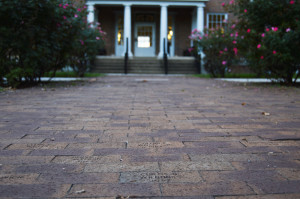The many faces of Carnegie Hall

Carnegie Hall: residence hall, Japanese school…hospital? Although many students have graced the halls of Carnegie through the years, few know the extent of the building’s history. Though now a co-ed residence hall, Carnegie has served many other purposes throughout its history. Carnegie has been an all male dorm, the site of a major fire, home to students preparing to fight in World War One, home to WWII Veterans and a temporary hospital among many other things.
The original Carnegie Hall began its life in the fall term of 1910 and was officially dedicated in January 1911. Containing only 3 stories, the original Carnegie Hall cost only $50,000 to build and was known as the “pride of the hill” according to a book of Maryville College history written by Samuel Tyndale Wilson.
In April of 1916, as Ms. Martha Hess, lead archivist at Maryville College stated, a small fire broke out in the original Carnegie Hall. Although this one was put out, a week later the building was completely destroyed by a fire. The origin of this fire is still unknown.
Though this loss was a terrible financial setback for Maryville College, many families throughout Blount County opened their homes to the homeless students. With no immediate funding to rebuild Carnegie, students and faculty held a parade in the streets of Blount County in May 1916 to help raise money for the rebuilding fund.
With the financial help from many Blount County citizens, the construction of the new Carnegie Hall began in June 1916 and was housing students by January 1917. The new building was five stories compared to the original three and was designed almost identically to the original.
When the United States entered WWI, Carnegie Hall was used as the barracks for some of the first members of the Student Army Training Corps (S.A.T.C.). When the government called for the mobilization of the S.A.T.C. on college campuses throughout the country, 76 students as well as some faculty were enrolled. The members of the S.A.T.C. were required to participate in regular on-campus military training in addition to their college studies.
As WWI drew to a close, Maryville College along with the rest of the world encountered another threat: the Spanish Influenza. When the Influenza hit the college in November 1918, the local Lamar hospital was completely filled with the sick. With nowhere to house any more patients, the hospital temporarily extended into the second floor of Carnegie Hall.
Several years later, Maryville College again was struck by the tragedies of war. During the heat of WWII, few young male students could be found on campus; however, as the war drew to a close, Carnegie’s basement became host to several families of veterans who then attended Maryville College.
Though it seems Carnegie Hall has seen its share of tragedies, its walls have also been home to many comical stories. In his book, Maryville College alum Lloyd Shue recalls one memorable dorm proctor (or resident director) Mr. Mac, and many young men who knew how to test his limits. Though he had to overcome a significant disability, Mr. Mac was well respected among the young men of Carnegie Hall and knew when a little joke could go a long way. Though Mr. Mac retired in 1959, the fun didn’t stop there.
“It was a zoo sometimes!” Maryville College alum Robert “Rob” Kennedy, class of ’71, recalls. The Carnegie Hall Kennedy knew was all-male, and girls were only allowed on special occasions. He remembers one such occasion spring of ’65 when Carnegie’s visiting hours were open to women.
Payphones were located on the 1st and 3rd floor. When a call came in, the one closest to the phone was expected to answer it and find the recipient.
“No one wanted to have the room right next to the pay phones,” said Kennedy.
In Kennedy’s time, rumors circulated concerning the existence (or lack thereof) of the dorm proctor, Mr. Lee Crippin’s toes. He was rumored to have tiny feet and walked with a bit of a limp. When Crippin made his rounds, residents knew his footsteps well enough to end their shenanigans when he came near. Unfortunately, the existence of Crippin’s toes remained a mystery.
Water fights have also been something of a tradition throughout Carnegie’s history. Shue tells of students pouring buckets of water on the heads of anyone who entered the building. Interestingly, Kennedy also remembers students doing the same thing with water balloons. Sometimes residents would wage wars with the water hoses that were later replaced with fire extinguishers.
Offering a bit of a different perspective, Coach Randy Lambert described what Carnegie was like in the mid 70’s. In his time, the ‘choice rooms’ were those on the wings. One of which, Lambert was glad to have. He recalls feeling as if he lived “in a tree house” because of the large tree that grew right outside his windows. By this time, the young men of Carnegie were “definitely allowed to have girls over” Lambert recalls.
“We were responsible, um, to a degree,” said Lambert when describing the residents’ behavior.



Great story, Allison! I assume the name Carnegie came from the famous Carnegie family who established and funded many Carnegie Libraries all across the U.S.